There’s been a change in my kitchen lately. Every now and then, I find myself surrounded by heaps of rock salt, spices, jars and baranis (glazed earthenware crock pots with lids), entering into a frenzy of activity, gripped by pickle mania. Not that I haven’t made pickles and enjoyed the process before. But it tended to be all about what I call the “glamorous” pickles: pork, fish and prawn, that are ready to eat practically as soon as the spices and oil are mixed in. These are big, dramatic pickles, which can be served up as a significant part of a meal, each one practically a dish by itself. They are very tasty, and friends always quickly claim bottles. I loved to hear how one particular friend, taking a bottle of my fish pickle home for the first time opened the lid, inhaled, and began eating pieces of pickled fish with her fingers, barely managing to save some for everyone else in her family.
But there are the other traditional pickles from Coorg – briny, fresh-flavoured, sour, infused with sparingly used spices: wrinkled hog-plums; crunchy bamboo shoots with green peppercorns; local limes; wild mangoes; bitter oranges and much more. These pickles take their own time to mature, for the spices to take hold of the fruit, and invariably, they get better with age. Much as I loved them –most times much more than all the meaty pickles – so long as someone gave me a bottle or two every year, it did not seem so important to make them. The truth of the matter is I did not have the patience for this kind of pickle. The kind that took days and weeks of your time, demanded attention, and did not yield instant results, and seemed altogether too complicated.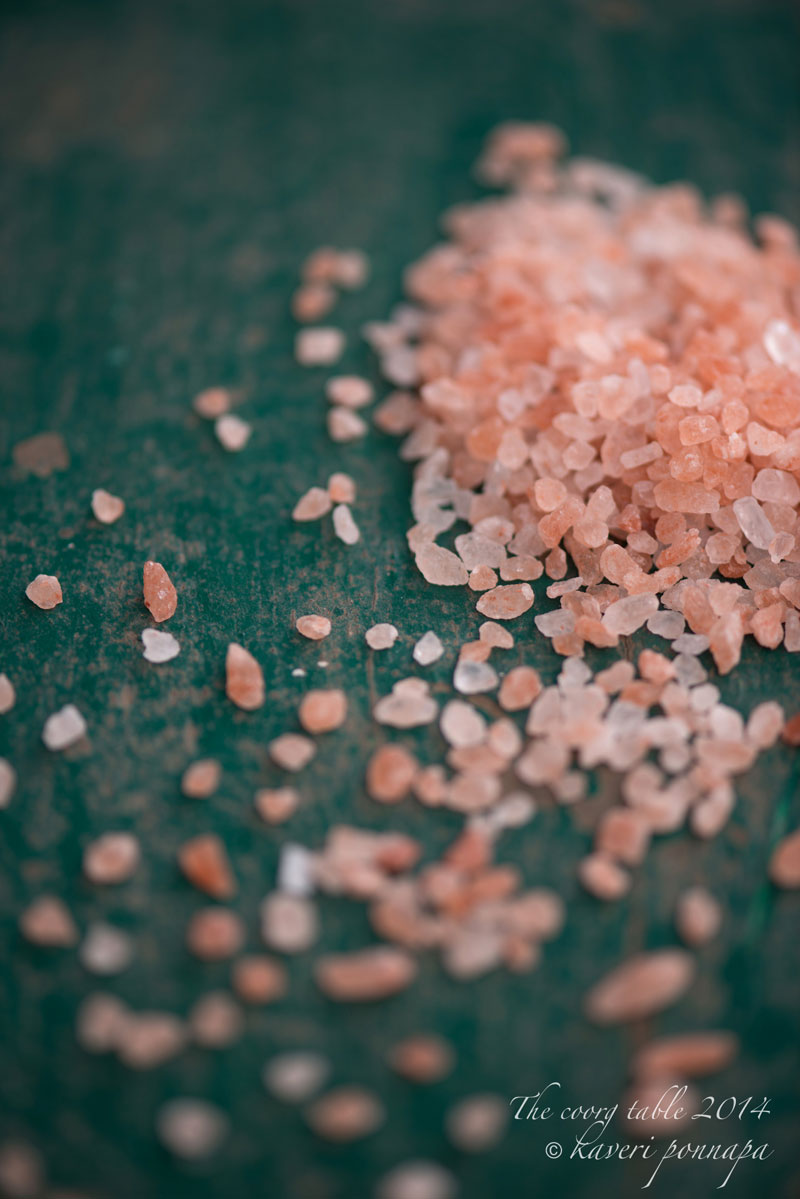
What’s happening in my kitchen right now is something quite different. Presented with bags full of various kinds of fruit from Coorg, I find myself looking at them through new eyes, and plenty of gratitude. I feel a great reluctance to waste the abundance of a season and the gifts from friends. I find myself becoming miserly about wasting even a single fruit, sifting and sorting through piles again and again, knowing that every one of them would serve a purpose.
So I decided to try my hand at salting, brining and preserving. A series of long distance phone calls to friends who are expert pickle makers, and I found myself on my way down an unfamiliar road. A very unfamiliar one, as I soon discovered, since being experts, there were many things my friends forgot to tell me about how the ingredients would behave. Making pickles with fruits and vegetables is a narrative, an inexact process, a story that you make up as you go along; one that refuses to be bound by precise measurements, instructions or recipes. There were disasters – like the first time I placed wild mangoes carefully in brine and covered the jar with a lid, not realizing that the fermentation process would send up gasses that needed to be released. After a couple of messy explosions and overflows, I figured that I needed to leave the jar partially open or, better still, tie the neck with a muslin cloth. It also took a day or two to work out that the fruit needed to be weighted down to keep it submerged; otherwise, it floated up in the brine and displaced quantities of it, which dried into extremely pretty crystals on my black stone floors – but that’s neither here nor there.
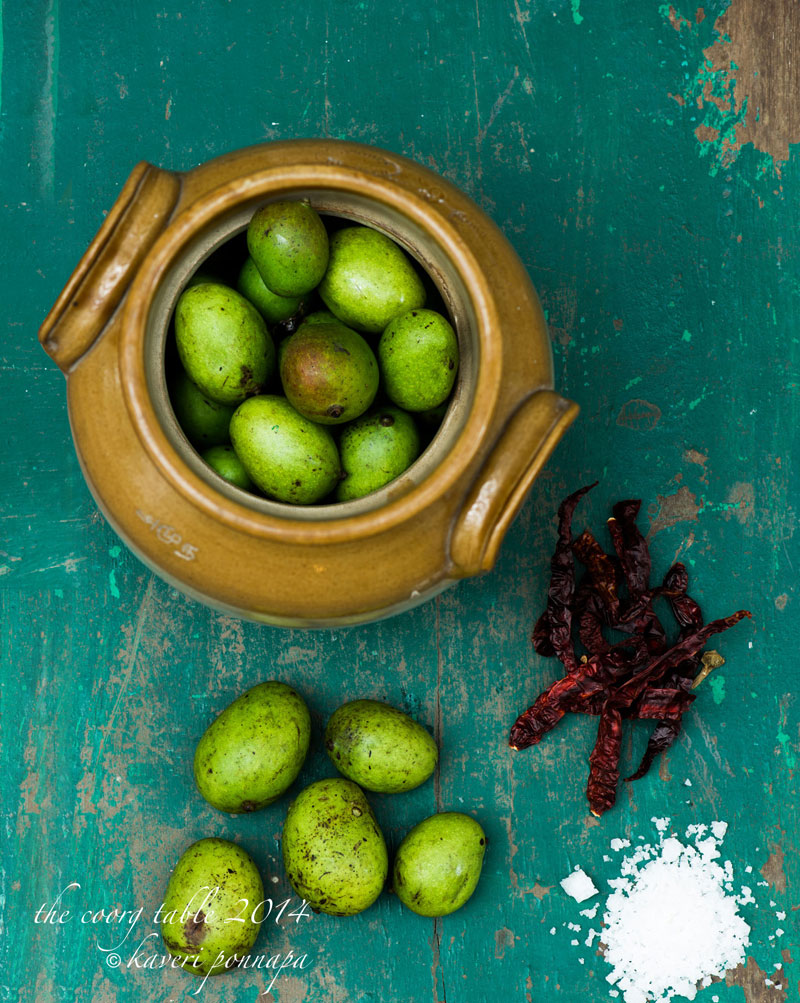
Very soon though, a beautiful rhythm set in: sorting, washing, sunning, wilting and brining fruit; watching and waiting for the right moment to add the spices, followed by more waiting as the pickles matured. Peering at the bottles day after day for any signs of change – and there always was: a slight bubbling; a deepening of colour; a change in the texture of the fruit. Salting was equally fascinating. I loved picking up fistfuls of rock salt crystals, and layering fruit and salt until the jar was full. Then the wait, as the salt slowly drew moisture from the fruit, turning it wrinkled and leathery, while the liquid levels rose and rose.
Pickle making requires patience and silence – in fact, the belief is that speaking while working, ruins the batch. If you begin to really immerse yourself in it, it is a deeply satisfying and contemplative activity. It sets you thinking about how important it once was to preserve food and flavours to tide you over the bleak monsoon months, to stretch out one season across another. In a day and age of shop bought wonders, where you can pick up jars and jars of every imaginable pickle, year round, off supermarket shelves, we’ve almost forgotten how exquisite the taste of a cherished, home made creation can be, and the community it creates through exchanges and gifts from the kitchen.
Salt is the essence of a pickle, an ingredient that we have learned to love since civilization began, one we cannot do without: “there is no better food than salted vegetables”, says an ancient Egyptian papyrus, confirming how long we have loved this mineral. Just think of what a wicked little mango, or a sharp slice of pickled lime can do for you: it can liven up the most ordinary meal, sharpen your appetite, excite your palate, send your mind spinning with emotion, and conjure up your native soil in one bite. Even after the spices have melted into your food, flavouring it deliciously, you can wander around with a left over, tiny mango or slice of lime. When you suck on it, it reveals its true, salty heart, and shouts out a flavour so intense that it makes your senses sing and your nerves tingle.
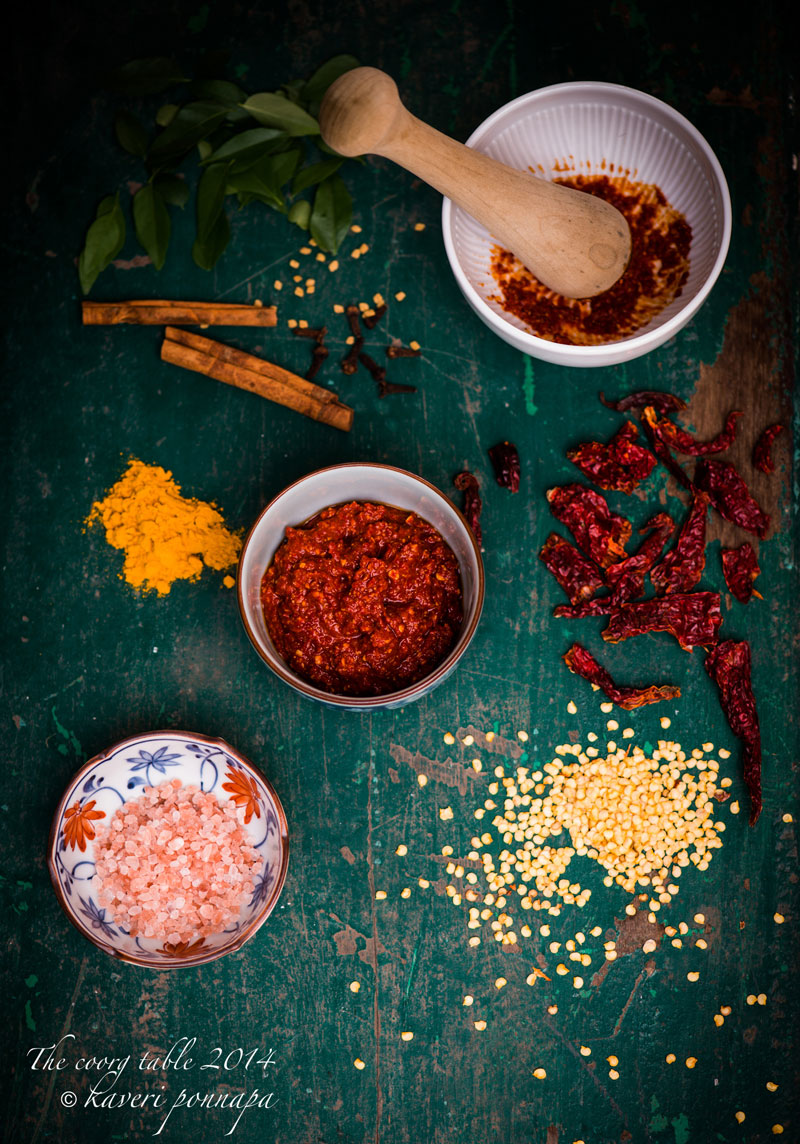
Alone in your kitchen, with fruit, salt and spices, there is plenty of space for your mind to wander and often, it drifts back to the past. Not so long ago, preparations for a wedding always brought a promise of pickles. A friend, neighbour or relative would drop by, and pledge a certain number of bottles of a special pickle for which she was justly famous. A few weeks before the event, she would come by again, carrying precious bottles wrapped in newspaper. There was always an air of ceremony about these exchanges; as aunts and grandmothers chatted over coffee and mid-morning treats the bottles were unwrapped, carefully counted, and stashed away with their companions, and meticulous mental notes made, to reciprocate at an appropriate date. I never really noticed, but it was always aunts, mothers-in-law and grandmothers who arrived with those bottles; and the same women packed those bottles for us when we left for college, or married and went to live elsewhere. All the women you remember, who made the most wonderful pickles, were never very young. Suddenly, you realize that the supply of homemade pickles has diminished; and when you look around, that comforting buffer of generous, older women is very small. You are aware that without any warning, abruptly, you are the age that your aunts once were, when the gifts of bottles of pickles came to you in such plenty.
Is there such a thing as the right age at which to be making pickles? I don’t really know, but I love where I am and what I am doing right now.
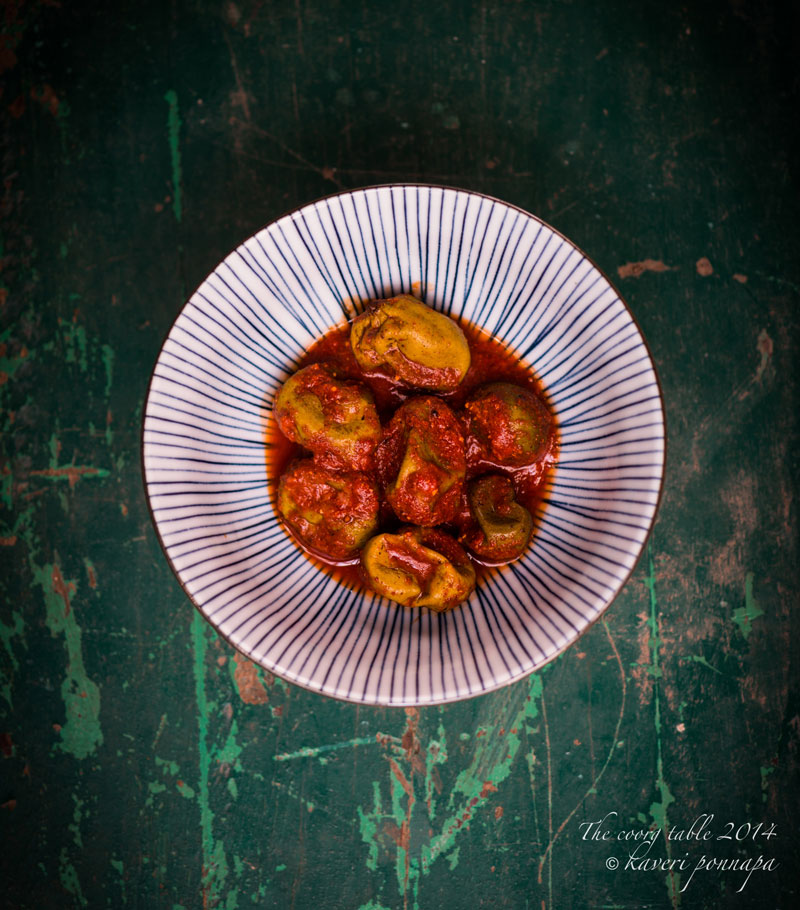
Kaad Mange Para
A Spicy Pickle of Wild Mangoes
This is not an exact recipe, as there are so many variables involved. But the general guidelines are accurate enough for you to experiment, and make your own version of an absolutely delicious pickle, which will last you for a full year, if not longer. Take 70-80, small, un-ripened wild mangoes, and wash them in salted water. Wipe and pat them dry, and place in a large stainless steel platter in the sun for 2-3 days, until they wilt, and begin to look slightly wrinkled. Roast about 500gms non-iodized rock salt on a clean tava for a few minutes. Allow it to cool; gauge the amount of water you would need to cover water to cover the mangoes, and make a brine solution with the roasted salt. Allow the solution to cool overnight. The next day, place the mangoes in a clean, dry jar, and pour the brine over it. You may need to place a weight, such as a ceramic saucer, or a small ceramic bowl to keep the mangoes immersed in brine. Tie the mouth of the jar with a clean muslin cloth. Set it aside for 7-8 days.
The mangoes will begin to get a wrinkled appearance. Take about 400 gms of baidige chillies, pound, break and de-seed them. Retain some of the seeds. In a small quantity of oil, fry the pounded chillies, cloves, cinnamon, fenugreek seeds, turmeric, according to taste. Dry roast a spoonful of sugar on a tava. Pour out just enough of the brine from the mangoes to grind all the roasted spices to a fine paste. You can add some of the chilli seeds if you wish to have a spicier pickle. Mix the spice paste thoroughly with the mangoes and the remaining brine. Ensure that all the fruit is well covered with the spice paste and liquid. Store for about 20 days or longer, to allow it to mature, and steep in the spices before eating.
Thank you for visiting this page. If you read something that you enjoy, or see an image that you like, please take a moment to write a response. Do look out for the recipes of all the food featured here in my upcoming cookbook.
Image Credits: Nithin Sagi
All Food Styling: Kaveri Ponnapa

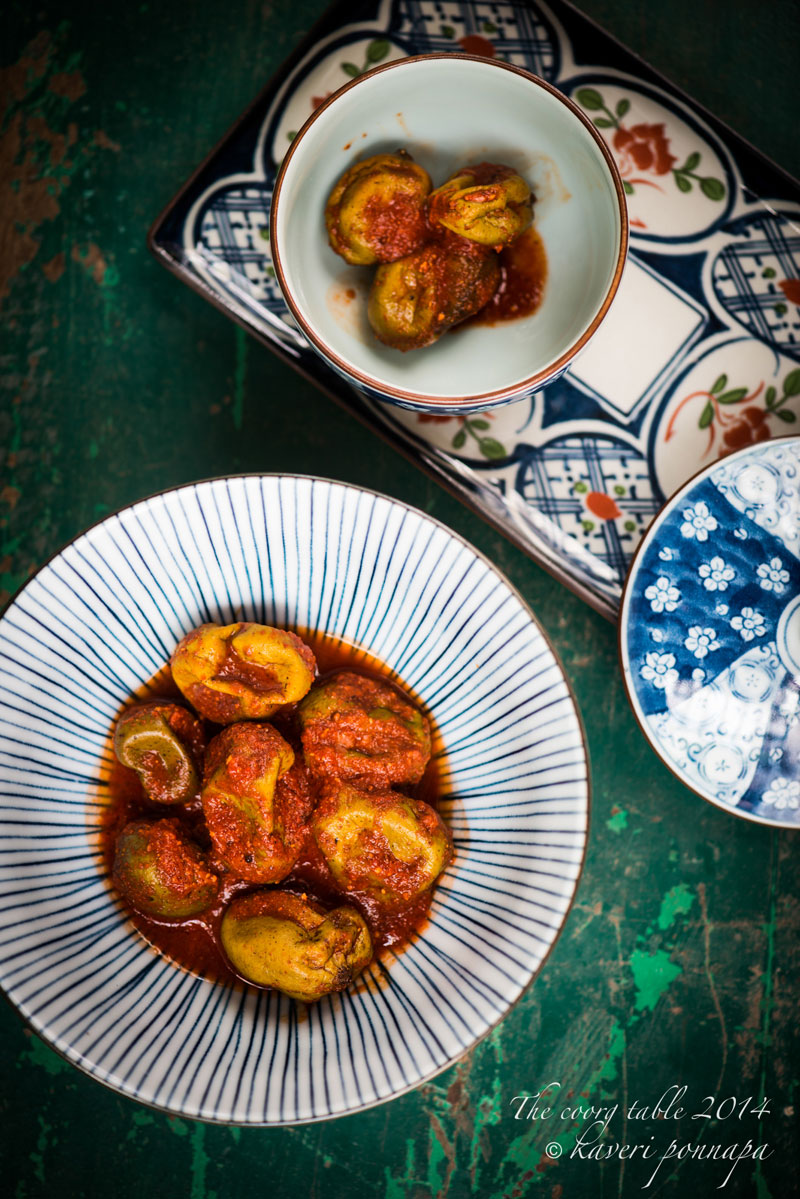



Absolutely loved reading this Kaveri!! Totally nostalgic as I could resonate with every word !
Love,
Vrinda
Thank you, Vrinda,glad it brought back pickle-making memories. Warmest wishes. Kaveri
How lovely! what a post.. someday in life, i hope to meet u and thank you.. till then.. i will do it right here..God Bless
Hello Pratibha, I, too, hope that we can meet sometime. I’m very glad you enjoyed reading this article. Thank you very much for taking the time to write, it always feels wonderful when a reader shares thoughts about a post. Warm wishes.Kaveri
Hi! M not much of a pickle person but the pic n the write up has woken up the new sense in me..u ve convinced me it is highly therapeutic n ll surely try to make these..btw could u recommend what all veg n fruits can v use for the same recipe?..some non veg pickles pls :)..u ve got me hooked to your story telling n writing skills…alongside ll get to learn loads..TIA
Hello Anuja, thanks for writing in and sharing your experience of reading this post. Pickle making really is very rewarding, especially when you taste the difference between what you buy in a store, and what you make yourself. The same process and spice combination given here is used to pickle ‘Ambatte’, in Coorg. It is called wild Mango, or Indian Hog Plum, ‘ambade’ or ‘ambada’. The recipe for lime pickle in Coorg uses a very similar method, with some variations, which I will post later. And yes, there are many delicious meat and fish pickles on the way. If you want any clarifications on the recipe, you can write to me at kaverikamb@gmail.com Good Luck! Kaveri.
This is so very interesting. I have never seen whole mango pickles. A query, do you place the saucer or bowl to weigh the mangoes down inside the jar? Don’t the mangoes push them up? Will share this recipe with my mother if she has any wild mangoes around. I have just started my pickling journey and am very intrigued by the brining method. We normally use oils.
Hello Ranjana, thank you for reading. Yes, the ceramic saucers are placed over the mangoes to weigh them down. They do push up against the top, and you will find a fair bit of brine getting displaced, so it’s best to place a ceramic plate or a thick layer of newspaper below the container.But it stabilises after a while—I have some fruit and vegetables preserved for years in this manner. I love these pickles, the flavours are very refreshing. Good luck with your trials. Best wishes.Kaveri
I will be visiting your website regularly to see your recipes, The recipes shown here brings some joyous moments of my past days…….Mudi mange pickle, Ambatte pickle, Baine pickle….. WOW! list grows memory never fades………Thank you!!!
Hello Kaverappa, you are very welcome to visit The Coorg Table, and the rest of this website as many times as you like – in fact, the more frequent your visits the better! After reading your comment, my husband and I remembered that my mother-in-law used to make the most fantastic Bainay pickle that we used to take back with us after a holiday. Everyone in the family seems to have forgotten it, so I will try and get a recipe, cook it, and post here. Thanks, and best wishes!Kaveri.